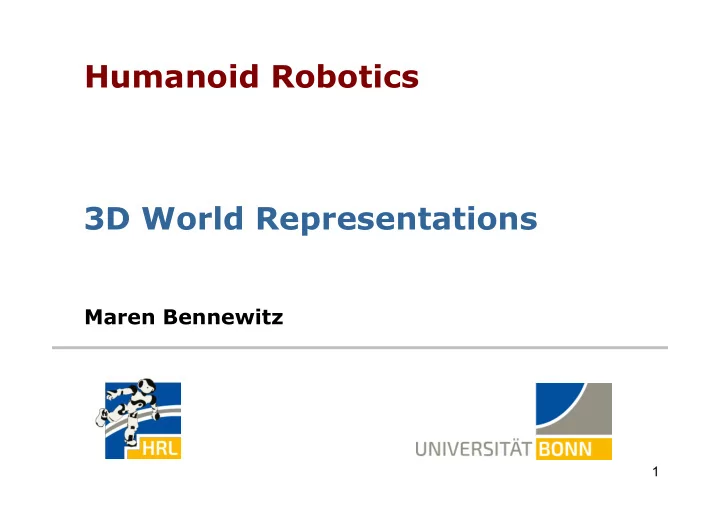

Humanoid Robotics 3D World Representations Maren Bennewitz 1
Robots in 3D Environments source: Honda 2
Motivation § Robots live in the 3D world § Collision avoidance, motion planning, and localization require accurate 3D world models § Given: 3D point cloud data from known robot/sensor poses § Question: How to represent the 3D structure of the environment? 3
Laser Scanning Principle Range scanners measure the distance to the closest obstacle 4 Image courtesy: Sick
Other Range Sensors – Kinect 5
Example: Data Acquisition 6
Popular Representations § Point clouds § Voxel grids § Height maps § Surface maps § Meshes § Distance fields § … 7
Point Clouds § Set of 3D data points § Created, e.g., by a laser scanner or depth camera 8
Point Clouds Pros § No discretization of data § Mapped area not limited Cons § Unbounded memory usage § No constant time access for location queries § No direct representation of free or unknown space 9
Point Clouds and Efficient Location Queries § Naïve implementation (list, array) has a linear complexity for location queries § More effective solutions through kd-trees § kd-trees operate in k-dimensions § Space-partitioning data structure for organizing k-dimensional points § Search/insert/delete in logarithmic time on average [see exercise] 10
Example: kd-Tree (2-dim.) Binary space partitioning Image courtesy: Wikipedia 11
3D Voxel Grids 13
3D Voxel Grids Pros § Volumetric representation § Constant access time § Probabilistic update possible Cons § Memory requirement: Complete map is allocated in memory § Extent of the map has to be known/guessed § Discretization errors 14
2.5D Maps: Height Maps Average over all points that fall into a 2D cell and consider this as the height value 15
2.5D Maps: Height Maps Pros § Memory efficient (2D) § Constant time access Cons § No vertical objects § Only one level is represented 16
Example: Problem of Height Maps 17
Multi-Level Surface Maps (MLS) 18
MLS Map Representation Each 2D cell stores a set of “patches” consisting of: § The height mean µ § The height variance σ § The depth value d Z Note: § A patch can have no depth (flat objects, e.g., floor) § A cell can have one or many patches (vertical gap, e.g., bridges) X 19
From Point Clouds to MLS Maps § Determine the 2D cell for gap size each 3D point § Compute vertical intervals based on a threshold § Classify into vertical Y and horizontal intervals X § For the vertical intervals determine: § The height and variance based on the highest measurement § The depth as the difference between the highest and the lowest measurement 20
Example: MLS Maps Point cloud Multi-level surface map 21
MLS Maps Pros § Can represent multiple surfaces per 2D cell Cons § No volumetric representation but a discretization in the vertical dimension § Several tasks in a MLS map are not straightforward to realize 22
Octree-Based Representation § Tree-based data structure § Recursive subdivision of the space into octants § Volumes allocated as needed § “Smart” 3D grid 23
Octrees 24
Octrees Pros § Full 3D model § Inherently multi-resolution § Memory-efficient, volumes only allocated as needed § Probabilistic update possible Cons § Efficient implementation can be tricky (memory allocation, update, map files, …) [see exercise] 25
Multi-Resolution Queries 1.28 m 0.08 m 0.64 m 26
OctoMap Framework § Based on octrees § Probabilistic, volumetric representation of occupancy including unknown § Supports multi-resolution map queries § Memory efficient § Generates compact map files (maximum likelihood map as bit stream) § Open source implementation as C++ library available at http://octomap.github.io/ 27
Ray Casting for Map Updates § Ray casting from sensor origin to end point along the beam § Mark last voxel as occupied, all other voxels on ray as free § Measurements are integrated probabilistically (recursive binary Bayes’ filter) given the robot’s pose end point sensor origin [Lecture on Cognitive Robotics] 28
Probabilistic Map Update § Occupancy probability modeled as recursive binary Bayes’ filter § Efficient update using log-odds notation [Lecture on Cognitive Robotics] 29
Lossless Map Compression § Lossless pruning of nodes with identical children § Can lead to high compression ratios [Kraetzschmar ‘04] 30
Office Building Example 31
Video: Large Outdoor Area Freiburg computer science campus (292 x 167 x 28 m ³ , 20 cm resolution) Octree in memory: 130 MB 3D Grid: 649 MB Octree file: 2 MB (bit stream) 32
Online Mapping With Octomap 33
Recommend
More recommend